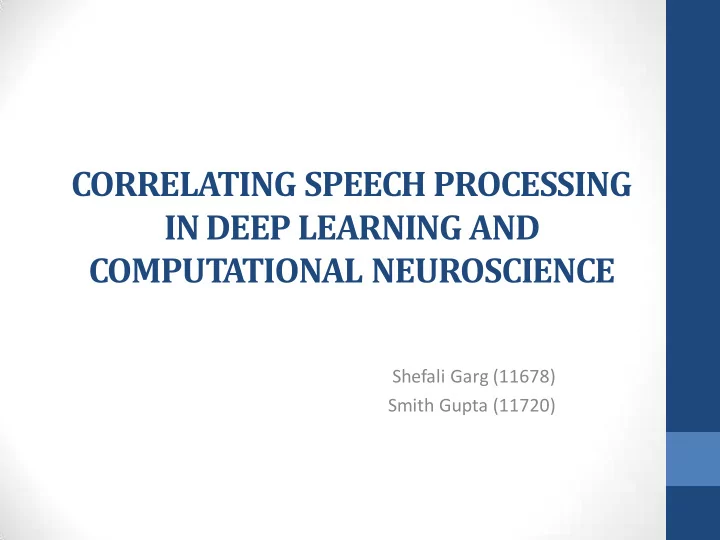

CORRELATING SPEECH PROCESSING IN DEEP LEARNING AND COMPUT ATIONAL NEUROSCIENCE Shefali Garg (11678) Smith Gupta (11720)
MOTIVATION • Speech Classification previously done through HMM and GMM [1] • "Deep Learning" approaches not being extensively used for speech processing • Task of Digit Classification done using DBN and MFCC features [2] • Using proposed CDBN methods [3] for Digit Classification • Relating extracted features and hidden units activation to neurons in brain
DATASET • A version of TIDIGITS dataset will be used for implementation of digit classification • Each speaker pronounces each digit twice
Methodology • Audio Feature Extraction Raw Features MFCC Deep Learnig • Classification by SVM
Audio Feature Extraction Raw Features • wav file spectrogram by FFT • Spectrogram represents the power of different frequency bands over time • Accuracy- 86.68% (Baseline)
Mel-frequency Cepstral Coefficients(MFCCs) • Take FFT of frame • Map the powers of the spectrum obtained onto the mel scale • Take DCT of the list of mel log powers • 42-dim feature vector containing information of amplitude, frequency , temporal variance (delta’s and delta -deltas) of spectrum • Accuracy- 92.79%
Deep Learning • when sparse coding models are applied to natural sounds (auditory signals), the learned representations (basis vectors) showed a striking resemblance to the cochlear filters in the auditory cortex
Deep Belief Networks • Complete bipartite undirected probabilistic graphical model • Network assigns a probability to every possible pair of a visible and a hidden vector via a energy function Image source : wikipedia
Convolutional Deep Belief Networks (CDBN) • Each neuron receives input from local limited frequency range • Hubel and Wiesel- cat’s visual cortex cells are sensitive to small local receptive field • Weight-sharing/Replicated Features- Neurons for same feature share weights • Probabilistic max-pooling- maxima over small neighborhoods of hidden units computed in a probabilistically sound way. • Invariance to small frequency shifts • Sparsity, prevent overfitting (less number of parameters) • Dimensionality reduction
• First layer bases of random file
FUTURE WORK • Relating features extracted in neural nets to features extracted in human brain • Broca‘s Area • Wernicke’s Area image source : wikipedia • According to recent research [6] features are extracted based on Plosives : p,t,k,b Fricatives : s,z,v Nasals : n,m
REFERENCES • [1] G. Hinton, L. Deng, G.E. Dahl, A. Mohamed, N. Jaitly, A. Senior, V. Vanhoucke, P. Nguyen, T. Sainath and B. Kingsbury, & ldquo, Deep Neural Networks for Acoustic Modeling in Speech Recognition,& rdquo, IEEE Signal Processing Magazine, vol. 29, no. 6, pp. 82-97, Nov. 2012. • [2] Audio Feature Extraction with Deep Belief Networks Visit Page • [3] H. Lee, P. Pham, Y. Largman , and A. Ng, “Unsupervised feature learning for audio classification using convolutional deep belief networks,” in Advances in Neural Information Processing Systems 22 , Y. Bengio, D. Schuurmans, J. Lafferty, C. K. I. Williams, and A. Culotta, Eds. Cambridge, MA: MIT Press, 2009, pp. 1096 – 1104. • [4] Abdel-Hamid, Ossama, Li Deng, and Dong Yu. "Exploring convolutional neural network structures and optimization techniques for speech recognition."INTERSPEECH. 2013. • [5] Abdel-Hamid, Ossama, et al. "Convolutional Neural Networks for Speech Recognition." (2014). • [6] Nima Mesgarani, Connie Cheung, Keith Johnson, Edward F. Chang, Phonetic Feature Encoding in Human Superior Temporal Gyrus. (2014)
THANK YOU!
Recommend
More recommend